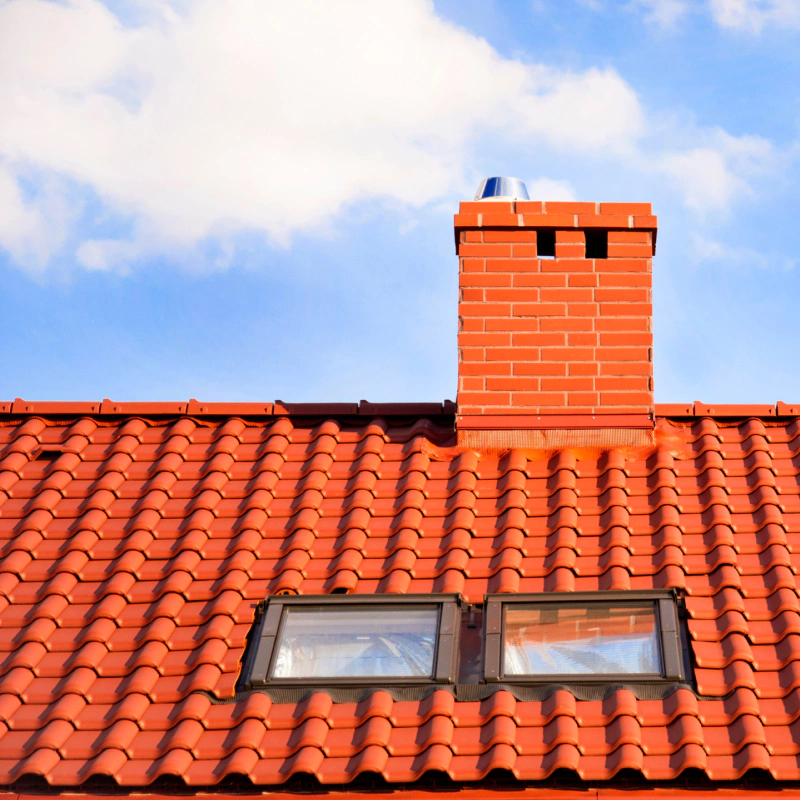Experienced Inspection Service at Your Fingertips
Roofing
Asphalt/Fiberglass Roofing
The sun is damaging roof materials. The south side of an asphalt shingled roof will wear out 3 to 5 years before the north side. Inadequate attic ventilation will also have a deteriorating effect on roof materials. Do not let debris accumulate on roof surfaces. This will keep the roof materials constantly wet or damp, which will promote the growth of fungus and mold. Tree branches overhanging a roof or in contact with a roof should be trimmed back.
The roof should be inspected annually by a knowledgeable, unbiased inspector. Any repairs small or large should be attended to immediately. Good maintenance is a key factor in preserving any roof.
The earliest signs of wear on asphalt/fiberglass roof shingles will appear as a granular loss. This means that the small mineral granules that are embedded in the surface of the shingles will wear away. The granules are there to protect the asphalt/fiberglass shingle from the ultraviolet rays of the sun. When sufficient quantities of the granules leave the surface of the shingles the sun will rapidly deteriorate the asphalt/fiberglass material. Other signs indicating the roof is approaching the end of its useful life are brittle shingles or shingles beginning to deform. When this is first noticed you will have about three years of life remaining to the shingles. This is usually the result of inadequate attic ventilation.
Asphalt/fiberglass roll roofing is large rolls of asphalt/fiberglass material with or without a granular finish. This type of roofing material is less expensive than shingle roofs, but will not last as long, possibly 5 to 7 years. This material tends to buckle and crack due to thermal expansion and contraction.
Wood Shingles
Wood shingle roofs come in basically two forms. Shingles, are uniform in thickness and cut relatively square; wood shake shingles are usually thicker and irregular, but they are also not square. This type of roof is 3 to 6 times more costly than asphalt/fiberglass shingles and can last 15 years or more. It is imperative that wood roofs have good air circulation, both over and under the shingles. Replace broken or damaged shingles on an as-needed basis. Decay is the culprit that will necessitate the replacement of this kind of roof. The ridge cap on the wood shingle roof is most susceptible to warping and splitting and should be replaced as soon as warping appears.
Slate Roofing
Slate roofs will last a lifetime as long as you maintain them on a regular basis. The life expectancy of a slate roof is directly affected by the quality of the slate and the fasteners. Some inexpensive slates known as “ribbon slate” can wear out in as little as 25 to 30 years, while some of the more expensive slates such as Buckingham slates are known to be in place in England for 800 years or more.
Winters can be particularly hard on slate roofs. Freeze and thaw cycles can cause slate to break off. Heavy ice and snow accumulations can slide off the roof carrying with it the slate tiles as well as the rain gutters at times. That is why on many slate roofs you will see small metal projections sticking up from the slate to break up the snow and ice into small pieces that can slide off the roof without causing damage.
Slate roofs are susceptible to physical damage. Walking on or throwing objects against a slate roof can and will probably break some of the slates. Do not allow any foot traffic on a slate roof that is not absolutely necessary. Replace broken and cracked slate regularly! Do not allow debris to accumulate on the roof surfaces. If your slate roof does not have snow and ice guards consider installing them. Do not let anyone walk on your slate roof without taking special precautions.
In the northeast slate is more than protection, in a way it is a status symbol. It represents high standards and quality, most often found in houses of distinction. Yet, in areas of Pennsylvania, New York, and New Hampshire where the slate quarries exist, you will find slate on the most modest of homes.
There are three most commonly used slates here in the northeast.
They are in order of durability; Multi-colored slates that range in color from grey to blue to rust; Grey slate that has more of a constant color and a hard shiny shell-like surface; Ribbon slate that is named after its particular characteristic resembling a ribbon. The slate is basically grey but has a 1 ¬? inch strip running through it. The strip referred to as the ribbon has a much darker color similar to charcoal grey, almost black. The ribbon appears as a solid strip running in a diagonal arc across the shingle surface.
General signs of wear are delamination, discoloration, fungi growth, and slipping or dislodged slates. Cap courses on the ridges and hips are most vulnerable to seepage. In order to keep the roof in good condition, annual maintenance by a professional slate roofer is advisable.
Cement & Clay Tiling
Cement and clay tile roofs are frequently found in the southern and western parts of the United States but less frequently in the Northeast. Like slate, the roofing tile will last many years if properly maintained. There are several types of cement and clay roofing tiles the most common being called “Mission or Barrel” tile. As this type of roof tile is prone to wind-driven rains blown under them, it is important to have a sub-roof installed for water tightness.
Maintenance on this type of roofing material is similar to slate. Replace broken or cracked tiles as needed. Refasten loose tile and flashings and keep the surfaces free from debris.
Asbestos Tile
Asbestos tile was used on a lot of older homes due to its long-lasting capabilities and low cost. In recent times asbestos has fallen out of favor due to environmental claims of the material being a carcinogen in its friable forms. The roofing material is very brittle and easily damaged from physical contact. Mold and fungus growth will flourish on this material particularly if shaded by trees. As this growth will tend to keep the material damp promoting further growth, it should be removed. Liquid sprays should be available at building supply centers for this purpose, although this is a job better accomplished by a professional. As the material is no longer manufactured in the United States, the replacement of a few broken shingles may necessitate a complete re-roofing. Asbestos is classified as a hazardous material and requires special handling, therefore disposing of the old material may become expensive. Repairs and/or maintenance of asbestos roofing are better accomplished by those familiar with the proper handling techniques.
Metal Roofing
Very few residential structures are built today employing a metal roof. Galvanize and Terne metal was used on a lot of wrap-around porches of homes built in the 1920s through the 1940s. Like all other types of roofing, they should be kept clean of debris. Physical damage and loose connections should be repaired as soon as possible. Special paint coatings should be occasionally applied to protect the metal, not roofing tar as this will tend to trap moisture under the tar layer causing rapid deterioration of the metal. Copper and aluminum roofing materials are cared for similarly to galvanize and terne except a protective coating is generally not required.
Generally speaking, flat roofs in a residential environment tend to be problematic. Leaks when they develop are difficult to locate, therefore difficult to repair. Ventilation of flat roofs is difficult, so in many cases is minimal or completely ignored.
Prior to the 1970″s the primary method for a flat roof installation was “built-up roofing” (B.U.R.) Method. This was achieved by applying layers of hot melted tar and black roofing paper. The quality of the roof covering was predicated on the number of layers of tar and roof paper. The more layers the better the roof. As our technology of synthetic materials increased flat roof materials changed dramatically.
Roofing membranes consisting of rubberized materials started to replace B.U.R. These newer materials proved to be more reliable than the older B.U.R. methods and are now more frequently used over B.U.R. Although leaks may be easier to locate and repair properly, ventilation is still difficult to achieve and the various flashing connections are susceptible to leakage.
Debris tends to accumulate more on flat roofs than any other type of pitched roof and must be cleaned off frequently. As this requires walking on the roof, extreme care should be taken to avoid penetrating the membrane with foot traffic. If repairs are needed on this type of roofing a qualified professional roofer is usually required.
Miscellaneous Materials
Roofing materials can be anything that can be applied in a manner to shed water and withstand the elements. Glass, porcelain, thatch, and even gold were used. With most of these non-mainstream materials, it is better to have personnel who are familiar with them, work on them.
Summary
Because maintenance and repairs of roofs generally require walking on the roof surface, this type of work should only be done by those familiar with proper safety techniques and procedures. This is not the type of work that should be attempted by a novice. The danger of falling off a roof or ladder exists with all roofs and some are more dangerous than others.
Certain types of roofing materials can be quite slippery when damp or wet. The possibility of foot traffic damage exists if one does not know how to traverse the various materials. And the possibility of electrocution from overhead wires exists.
Generally, debris should be cleaned from roofs twice annually, in the spring and fall. Trees and shrubbery that come into contact or close proximity to the roof should be cut back. The growth of mold and fungus should be inhibited.
GET IN TOUCH
If you’re ready to get fantastic service, then call us today or fill out the form.




